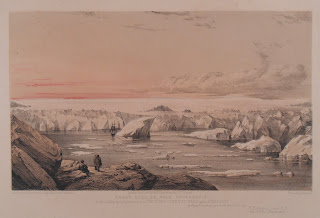It has been a bit nippy in the lower 48 this week with the arrival of the polar vortex. We were spared the worst of it, but still, temperatures have been well below zero the last couple of nights and yesterday was pretty brutal if you were facing into the wind. Luckily for us, we have the Stefansson Collection on Polar Exploration at hand, so whenever we feel too oppressed by the long winters in Hanover, we can find plenty of books that describe much worse. We can also find books that remind us of the pure beauty of winter, when the stars are crystals in the night and the sun sparkles off of the snow. Today, we will opt for the beauty.
To see more, ask for W. H. Browne's Ten Coloured Views Taken During the Arctic Expedition of Her Majesty's Ships "Enterprise" and "Investigator" (London: Ackermann, 1850) at Stef G610 .B88.
Friday, February 1, 2019
Tuesday, January 29, 2019
Flaming Red Communism at Dartmouth
One of the great joys of working in special collections is the serendipitous discovery of some small detail that further expands our knowledge about a subject or aspect of Dartmouth's history. We've blogged before about how Rauner Library was part of the Shared Academic Experience as part of New Student Orientation back in September of 2018. Incoming freshmen visited the Orozco murals in the basement of Baker Library with Professor Mary Coffey and then came over to Rauner Library to see archival films, Orozco's original sketches from the Hood Museum, and examples of how the murals were received by Dartmouth students and alumni. For the same event, we happened upon a letter written by President Ernest Hopkins to Dartmouth's Treasurer, Halsey Edgerton. In the memo, Hopkins provides a hint of some interesting and somewhat humorous details related to the Mexican muralist who had been commissioned to paint the frescoes at Dartmouth amid a fair bit of controversy.
The first item of interest is that Orozco was one of two "sensations in mural painters" that were in the zeitgeist; the other painter that Hopkins alludes to is Diego Rivera. The college, with the encouragement of the Chair of the Art Department, Artemus Packard, had originally considered bringing both artists to campus, but the funding didn't pan out. Instead, Packard chose Orozco because his work was more in the traditional style than Rivera's. It's also interesting to note that money from the Rockefeller (yes, those Rockefellers) tutorial fund was used to pay Orozco because he was brought to campus as an instructor and not merely a muralist. One might catch a whiff of hypocrisy in Orozco's willingness to receive Standard Oil money in exchange for his services, given that Hopkins describes him as a "flaming red communist." However, even if Orozco was aware of where the money was coming from, he clearly didn't have a problem with vocally rejecting exploitative capitalism even as he benefited from him. As Hopkins notes, Orozco once told a wealthy patroness that he hoped she would be assassinated, even while he was in the midst of painting a fresco for her in her own home.
The institution of Dartmouth College, thankfully, was exempt from Orozco's fury because he considered it to be "eleemosynary," or a site of charitable giving. However, he still felt (at least according to Hopkins) that the faculty should be "annihilated." With that in mind, Hopkins closes the letter by warning Treasurer Edgerton not to oppose Orozco at any point. He playfully says that he'd "hate to lose a good treasurer" and that Edgerton represents "all that he [Orozco] abhors."
To take a look at the correspondence related to the painting of the Orozco murals, come to Rauner and ask for the Collection relating to the work of Jose Clemente Orozco (DL-34, Box 6122, Folder 23).
The first item of interest is that Orozco was one of two "sensations in mural painters" that were in the zeitgeist; the other painter that Hopkins alludes to is Diego Rivera. The college, with the encouragement of the Chair of the Art Department, Artemus Packard, had originally considered bringing both artists to campus, but the funding didn't pan out. Instead, Packard chose Orozco because his work was more in the traditional style than Rivera's. It's also interesting to note that money from the Rockefeller (yes, those Rockefellers) tutorial fund was used to pay Orozco because he was brought to campus as an instructor and not merely a muralist. One might catch a whiff of hypocrisy in Orozco's willingness to receive Standard Oil money in exchange for his services, given that Hopkins describes him as a "flaming red communist." However, even if Orozco was aware of where the money was coming from, he clearly didn't have a problem with vocally rejecting exploitative capitalism even as he benefited from him. As Hopkins notes, Orozco once told a wealthy patroness that he hoped she would be assassinated, even while he was in the midst of painting a fresco for her in her own home.
The institution of Dartmouth College, thankfully, was exempt from Orozco's fury because he considered it to be "eleemosynary," or a site of charitable giving. However, he still felt (at least according to Hopkins) that the faculty should be "annihilated." With that in mind, Hopkins closes the letter by warning Treasurer Edgerton not to oppose Orozco at any point. He playfully says that he'd "hate to lose a good treasurer" and that Edgerton represents "all that he [Orozco] abhors."
To take a look at the correspondence related to the painting of the Orozco murals, come to Rauner and ask for the Collection relating to the work of Jose Clemente Orozco (DL-34, Box 6122, Folder 23).
Subscribe to:
Comments
(
Atom
)


